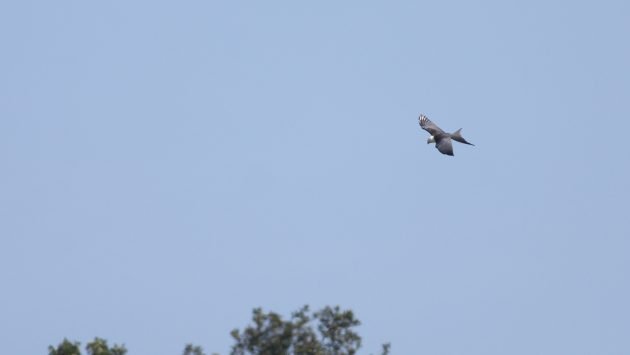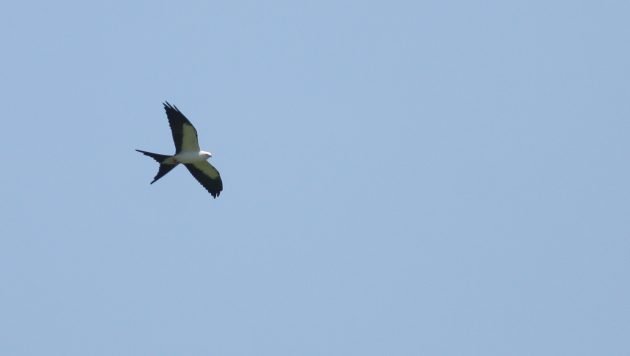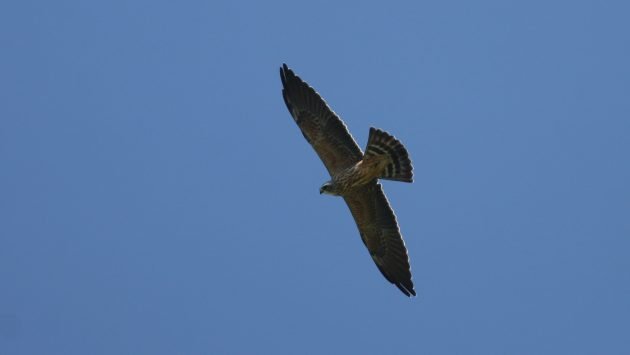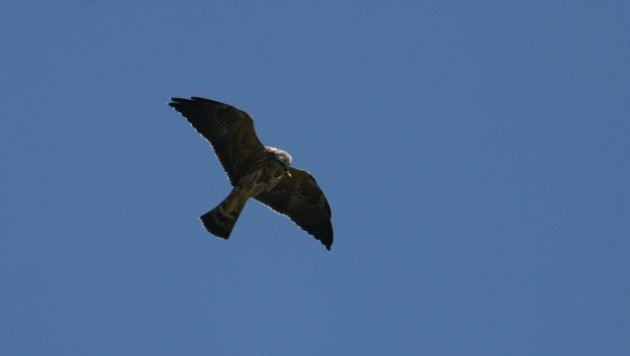
To say that my birding has been limited this year is an understatement. My spring and early summer were sucked away from me by the work involved in producing a new field guide to the Carolinas. That project is mostly complete now, but life has a way of stealing that time you’d rather spend birding, and the oppressively hot summer has made the prospect of standing out in the buggy wilderness staring at messy molting birds and squawking fledglings less than appealing. So while I may have a hard time calling myself a birder in practice of late, the spirit is still there, particularly when a good bird shows up nearby.
Swallow-tailed Kite is an enigmatic species in North Carolina. It was only in the last five years that they were confirmed to nest in the state, in the swampy forests along the lower Cape Fear River, despite being seen fairly regularly in the area for years. I’ve never had a ton of success chasing these birds, however, even in the late summer when the adults and the year’s juveniles tool around looking for hay-cutting farmers whose tractors kick up flying insects for the kites to dine on. Outside of this corner of the state the birds can range widely, showing up in random fields in all corners of North Carolina. They hang around for a day or two, then move on to wherever kites go when they’ve picked the skies clean of cicadas and lubber grasshoppers. Mexico, probably. In any case, August is kite month, if you’re lucky enough to cross paths with them.
And 2016 is kite year, evidently. Swallow-tailed Kites, and their equally graceful but less ostentatious cousins from Mississippi, have been found in at least a half-dozen fields in North Carolina in the last couple weeks, including a field not more than an hour from my home. In the hopes of salvaging something new for the state from the warm part of the year in 2016, I headed out the next morning.
The birds did not make me wait long. Just after 10, the first Swallow-tailed Kite coursed effortlessly over the shoulder-high corn. It was joined by a second, and eventually a third, making lazy circles over the tree line, snagging insects too small for me to see but large enough to justify the birds’ continued presence.
Swallow-tailed Kite has to be on the short list of the most dramatic bird in the ABA Area. We have large hummingbirds and colorful warblers and flashy jays but there’s nothing quite like the pied raptor with the bulging eyes and the bifurcated tail. It looks like something that would be more at home gliding over the African savannah rather than a random hayfield in foothills of the Appalachians. And though they are fairly common in the neotropics, where garish birds feel more acceptable, it’s still a trip to have them so close to my own, unremarkable, home.
There was a pair of Mississippi Kites hanging around as well. Young birds, with coarse streaked breasts and banded tails – little like the clean, gray adults. They were more curious, or at least less annoyed by the presence of a handful of birders pulled over on the gravel road across from their field. They made near passes, eyeing us closely.
I have Mississippi Kites in my own hometown. Their distribution in North Carolina is strange. They are rather common in the lower coastal plain, but stake out colonies in the older neighborhoods of larger cities like Charlotte and Greensboro. They don’t need a lot in the way of habitat. Only some mature trees in which to nest, and from whose perches they can spiral hundreds of feet into the air to hunt for high flying insects. You can find them in the morning, flying lazy circles higher and higher before disappearing into the sky. But these young birds had no interest in that, staying nearby and hawking cicadas with relish. The pickings were apparently excellent.
These birds stuck around for the rest of the week, with as many as nine Swallow-tailed Kites making an appearance before the end. When the farmers finished baling the hay the birds moved on, in search of another field most likely, before the long journey south.

















I’ve only seen Swallow-tailed Kites in Tikal in Guatemala. Outstanding raptors.
I loved seeing Swallow-tailed Kites for the first time this spring in the Everglades. Someday I will see one in New York for my state list…until then I shall live vicariously through those who can drive one hour to see them.